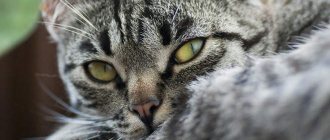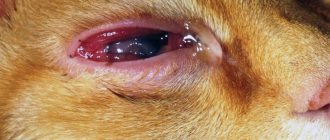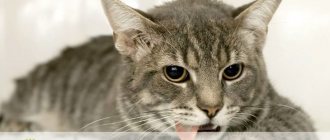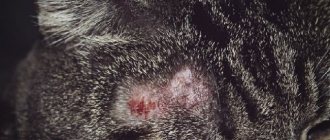Anastasia Dmitrievna Mitryaykina
veterinarian Petstory
Conjunctivitis in cats is an unpleasant but extremely common disease. Let's figure out what conjunctivitis is like, what can cause it, how dangerous it is, what its manifestations are and how to protect your pet from it. How to act correctly and organize treatment if you have already discovered symptoms of conjunctivitis in a cat? Read about all this and more in this article.
So what is conjunctivitis? In general, when the name of a disease ends in “-itis,” this means that it has an inflammatory cause.
For example:
- Gastritis - inflammation of the stomach;
- Dermatitis is inflammation of the skin;
- Conjunctivitis is an inflammation of the mucous membrane of the eye.
Photos of conjunctivitis in cats
What is the conjunctiva and why does it become inflamed?
The surface of the eye is covered with the conjunctiva. This is a thin mucous membrane necessary to moisturize the eyeball. Maintaining the correct level of humidity occurs through the distribution of tear fluid over the entire surface. Any irritation can damage the sensitive membrane. And since there are many nerve endings and blood vessels on it, inflammation and painful sensations immediately occur.
Doctors distinguish different forms of eye conjunctivitis in cats:
- Primary
arising from infection.
- Secondary
which is a symptom of another illness.
- Spicy
, which is characterized by a clear clinical picture of all signs of inflammation.
- Chronic
, proceeding sluggishly for a long time.
Any form of inflammation is well treated. But complete relief from the problem is only possible if you consult a doctor in a timely manner and follow all his recommendations.
Causes of conjunctivitis in cats' eyes
Many factors can provoke the occurrence and further development of inflammation of the mucous membrane of the eyeball. Subsequent treatment depends on them.
Infections
Microbes, fungi and viruses are the most common sources of pathology. The infection can enter directly into the organ of vision or affect a separate system of internal organs.
Eyes are an indicator of the health of an animal. And any ailment caused by viruses or bacteria necessarily manifests itself in redness and suppuration of the thin membrane.
Injuries and debris
Contact with a foreign body on the conjunctiva causes discomfort in the eye and leads to mechanical damage. And all wounds, wherever they arise, become gateways for infections. A large volume of tear fluid produced can significantly reduce the number of bacteria, but if the damage is severe, inflammation is inevitable.
Chemical exposure
Contact of chemicals or other substances on the mucous membrane leads to terrible burns, causing blindness or even death of the animal. No less dangerous are the chemical fumes that curious individuals inhale. As soon as you leave an open bottle of solvent or a can of paint, a cat or kitten will immediately sniff the pungent-smelling object.
Particularly curious mustaches are interested in packs of washing powder or other household chemicals. Therefore, all chemicals, even seemingly harmless ones, should be hidden from your pet in locked cabinets.
Allergy
The effects of allergens on the human body and the four-legged friend are largely similar. A living creature begins to sneeze, cough, and itchy and flaky areas appear on the body.
In addition, allergies are accompanied by a sore throat and profuse lacrimation; as a result, the mucous membrane begins to swell, turn red and itch very much. To heal, it is important to identify the source of the body’s reaction and eliminate it. In some cases, the veterinarian prescribes antihistamines.
Irradiation
We are talking about different forms of exposure to the pet’s body: ultraviolet, radioactive or x-rays. Lamps with ultraviolet elements, illumination of aquariums and terrariums lead to damage to the retina and inflammatory processes inside the organs of vision. Subsequently, constant exposure to ultraviolet radiation impairs the ability to see and leads to complete or partial blindness.
Infection with worms
Intestinal parasites entering the body lead to a large number of health problems. First of all, it is worth noting the sharp deterioration in the immune system of the infected animal. This contributes to the formation of inflammation and allergies to waste products of worms.
Spread of inflammation from a neighboring area of the body
Diseases of the nasolacrimal ducts and cornea of the eye lead to infection of the mucous membrane. This is due to the interconnectedness of the functions of these departments. Inflammation can also spread from the skin around the eyes.
Prevention
Prevention measures for any disease are directly related to understanding the cause of the disease.
Thus, for conjunctivitis it is:
- Strict adherence to zootechnical maintenance standards. Lack of overcrowding of animals, quarantine of new arrivals (kennels, foster care), good nutrition, fresh air (under no circumstances should you keep a cat in a smoky room, because this will certainly lead to the need to treat allergies and, accordingly, conjunctivitis).
- Timely vaccination of animals . There are effective vaccines against calicivirus and rhinotracheitis, and immunoprophylaxis for chlamydia is also available.
- Secure the containment environment . Remove cacti and chemicals from access; do not allow cats to walk on their own, do not keep conflicting animals in a common area.
Types of pathology
The forms of conjunctivitis in a cat affect the treatment that the veterinarian will prescribe. It is quite difficult to independently determine the type of problem.
Catarrhal
Catarrhal appearance becomes a harbinger of the appearance and development of even more serious eye diseases of the viral type - if it is not stopped immediately. This pathology is not considered dangerous and is most often caused by the penetration of various types of streptococcal and staphylococcal infections into the lacrimal sac. If the owner noticed the problem in time and contacted a veterinarian, then the catarrhal form can be cured in a week.
Allergic
This type can be caused by various allergens: unsuitable food, pollen, dust, household chemicals. So-called “trails of tears” form on the mustachioed friend’s face. They give your pet an unkempt appearance and over time acquire a reddish tint.
Redness and swelling occur due to excessive tearing and subsequent irritation. Most often, breeds with a short muzzle, as well as individuals of white or light colors, suffer from allergic manifestations.
Purulent
Purulent conjunctivitis in cats most often occurs due to mechanical damage and subsequent infection of the wound. It is characterized by the formation of cloudy green pus and crusts in the corners of the eyes.
Gradually, the eyelids become swollen and stick together, and hair falls out around them. In advanced cases, an unpleasant odor is noticeable. Symptoms of the purulent form include high fever, weakness and photophobia.
Follicular
This type of pathology develops due to untimely or improper treatment of catarrhal type. The follicular form is caused by bacteria, fungi and viruses that have entered the organ.
The disease manifests itself not only in redness and swelling, but also in enlarged lymph nodes. The suffering furry constantly squints and blinks more often. All this happens due to spasm of the muscles of the eyelid. A cloudy film is visible on the animal’s eyes, and pus is mixed with the tear secretions.
The eyelids become covered with red bumps called follicles. Because of them, the skin of the eyelids begins to turn outward. The doctor, having assessed the patient’s condition, will immediately prescribe treatment. If you ignore the problem, the animal will go blind.
Viral and fungal
This is the most common type of illness. It is caused by almost any viral or infectious disease caused by pathogens entering the organs of vision. The cat's eyes begin to water heavily, and crusts form due to purulent discharge. If you do not get help, this variant of the disease can become dangerous and lead to further infection.
Phlegmonous
Fortunately, this dangerous variant of the pathology is extremely rare, because it is a consequence of a serious chemical burn. An acid or chemical may get into your cat's eye. In this case, it is almost never possible to save vision, because a complete retinal detachment occurs, and the apple is covered with a cloudy film.
Parenchymatous
The parenchymal type of inflammation affects not only the superficial membrane, but the entire eyeball. Bleeding crusts appear around, the tissue becomes dense, and small tubercles form. The natural color of the mucous membrane changes to a cloudy brown color. Without properly selected drug therapy, the animal becomes completely blind.
Photo gallery
Chronic conjunctivitis in a cat
Photo 2. Acute conjunctivitis
Photo 3. Kitten with purulent conjunctivitis
Symptoms of feline conjunctivitis
Before treating conjunctivitis in cats, the veterinarian pays attention to the characteristic clinical picture of the disease. It would be a good idea for the owner of a four-legged friend to know about the main manifestations of the disease in order to contact the clinic in time.
External signs
More than half of infections occur in only one eye. If you do not stop the infection, then in a few days problems will begin with the second eye.
The main signs of pathology include:
- photophobia;
- swelling and redness of the mucous surface;
- the cat's desire to wash his face frequently;
- lethargy and apathy;
- refusal to eat;
- temperature increase;
- crusts around the eyes;
- trails of tears mixed with red discharge;
- pus and stickiness of the eyelids.
All the symptoms of conjunctivitis in cats are not always immediately noticeable, and the doctor prescribes treatment based on the first signs to prevent subsequent complications.
The disease occurs in both adults and newborns with closed eyes. In kittens, infection is noticeable by swollen eyelids and crusts of purulent discharge.
When you need to urgently contact a veterinarian
You should not choose treatment on your own, but you can help your pet before visiting a doctor: just wipe the affected eye with furatsilin solution or strong tea leaves at room temperature. If after two wipes the condition does not improve, show the cat to the doctor - perhaps he needs more serious treatment.
You can’t hesitate if a small (up to 3 months) kitten is sick. In children, some diseases develop rapidly and can lead to death in just a few hours. Therefore, urgent assistance from a veterinarian is necessary in their case.
Which breeds are more susceptible to this disease?
There are breeds with better health. There are many breeds with poor health due to their skeletal structure. According to the observations of specialists, cat breeds that have genetic features of the structure of the eyeball are more susceptible to the occurrence of various types of conjunctivitis. The following are the cat breeds susceptible to the disease.
- "Burmese" - the breed has congenital keratoconjunctivitis, ectropion of the third eyelid, and a large percentage of damage from viral conjunctivitis.
- Exotic shorthaired breed - hereditary increased tearfulness can occur due to allergic conjunctivitis.
- The Himalayan cat has hereditary cataracts; the weak structure of the eyeball is susceptible to viral diseases.
- "Manx" - this breed has a frequent occurrence of corneal diphtheria, which is accompanied by severe swelling. Symptoms can easily be confused with conjunctivitis and the wrong treatment may be chosen.
- The Persian cat is a breed with poor health by nature; there is a peculiarity of the breed – increased lacrimation. Since the immune system is weak, the risk of conjunctivitis is high.
- The Siamese cat has congenital vision problems, often leading to blindness. Suffers from primary glaucoma. Owners of this breed should strictly observe all measures to prevent conjunctivitis.
- Bengal cat - kittens are often born with entropion of the eyelid; if surgical intervention is not performed, ulcers will appear on the cornea, which leads to blindness. The weak point of the breed is the eyes.
This does not mean that these breeds should not be kept in the home. If you follow all preventive measures and take proper care of your pet, cats are not afraid of any diseases.
Diagnostic procedures
After a thorough examination of the patient, the doctor will talk with the owner. The specialist will be interested in changes in the behavior of the furry, the time of appearance of signs of illness, and some nuances in the daily life of the whole family. Further diagnostics include:
- Blood sampling for general and clinical tests.
- Taking a swab from the mucosal surface for laboratory testing to determine the type of infection.
- Determination of sensitivity to antibiotics through culture of eye secretions.
Modern clinics offer biomicroscopy. This research method helps to examine the eyelids, mucous membrane, cornea, iris and part of the lens in a few minutes. Biomicroscopy gives more accurate results, which helps to choose the optimal treatment.
How to treat conjunctivitis in a cat
To alleviate the condition, the pet needs to be provided with peace and the opportunity to be in a room with dim lighting. In addition, it is extremely important to follow all recommendations from your veterinarian.
Prescribing tablets and injections in difficult cases
Only a doctor can prescribe medications and their dosage. Self-administration of medications can cause a deterioration in the patient's condition.
Therapy depends on the type of disease: in case of an allergic form, antihistamines are used, and if the nature of the disease is viral or infectious, then a course of antibiotics or antivirals helps.
Treatment with tablets or solutions is carried out under the strict supervision of a veterinarian, who, if necessary, discontinues the drug, changes its dosage or prescribes a similar remedy.
Drops and ointments
The use of drops and ointments intended for treating people is strictly prohibited. Many of them cause serious visual impairment in the pet due to too high a concentration of the medicinal substance, and some types lead to blindness. For example, Albucid is not suitable for mustaches, although it helps children and adults.
The following ointments and drops for conjunctivitis in cats, recommended by veterinarians, have worked well:
- "Tsiprovet";
- "Leopard";
- "Iris";
- "Ophthalmosan";
- "Tetracycline".
The use of drops depends on the form and type of virus, infection and complexity of the disease. Usually the solution is prescribed four times a day, 2-3 drops in each eye. The ointment is placed behind the eyelid and lightly massaged without pressing on the apple. It is important to monitor the progress of the disease and, in case of complications, re-visit the veterinary clinic.
Washing
The washing procedure cannot replace full-fledged drug therapy, but it will significantly improve the patient’s condition and speed up his recovery. Also, the diseased eye must be washed before applying the medicinal ointment.
For manipulation, it is recommended to use a 0.02% solution of furatsilin, 0.01% chlorhexidine, or 0.9% saline solution. Rinsing can only be done with clean hands, using sterile means at hand. There are two ways:
- The eyes are wiped with a gauze cloth soaked generously in the solution in the direction from the temple to the nose.
- The composition is carefully poured into the upper outer corner of the eye using a syringe without a needle or pipette. Then blot the remaining liquid with a dry gauze cloth.
At home, the procedure is performed at least 3 times a day. It is more convenient to do this with four hands in order to securely fix the pet and quickly rinse. If everything is done correctly, the animal will notice a significant improvement in its condition.
Is it possible to use folk remedies?
Folk remedies in the form of tinctures and decoctions “cooperate” well with drug therapy. Homemade drugs help only with uncomplicated cases of infection, for example, with the catarrhal type of the disease.
Here are the most common means:
- Rosehip infusion is made from 2 teaspoons of dry raw materials and a glass of water. The mixture is boiled for 5 minutes and left until completely cooled. The animal's mucous membrane is washed with the strained solution.
- Mix Kalanchoe or aloe juice with boiled warm water in a 1:1 ratio and wipe the eyelids with this mixture.
- Dill has an anti-inflammatory effect, so moisten a bandage with freshly squeezed juice and wipe the eyelids.
Folk remedies should be used under the supervision of a specialist, making sure that the pet does not develop an allergy to the medicinal plant. All solutions and decoctions are designed to soften purulent crusts, which facilitates their painless removal, and eliminate itching and pain.
Diagnosis of the disease
In order to accurately establish a diagnosis, a number of conditions must be met, such as collecting primary data to establish the cause (history), which includes clarifying a number of questions: whether the animal is vaccinated regularly annually, whether there was contact with other animals that looked sick. Redness occurs in one eye or both. How long ago did the owners notice, are there any other changes, what is the nature of the discharge from the eyes, etc. Then the doctor must look at the eyes using special instruments. If necessary, blood biochemistry and infectious diseases tests, bacteriological studies, and cytological studies of scrapings from the conjunctiva are taken.











